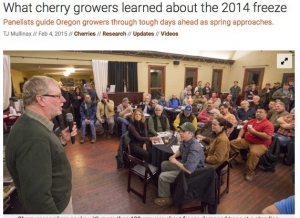Tree fruit producing areas particularly hard hit were Oregon’s Mid-Columbia district (The Dalles, Dufur, and Hood River) and Milton-Freewater. Pockets of Washington suffered damage, but not to the extent of Oregon. Low temperatures in the Mid-Columbia registered 6° to -4°F. Young fruit trees are particularly vulnerable to freeze damage.
How to respond to freeze damage has been the topic at several winter meetings in Washington and Oregon. Extension researchers and educators have been challenged in giving advice because damage like this—to spurs and cambium of cherry trees—hasn’t occurred for decades. Some compare it to the historical Northwest freeze of 1955.
Cold winters and spring frosts often kill some flower buds. Sweet cherry trees can lose half of their flowers and still have a full crop.
But damage to spurs is another story.
If buds are live but the spur is dead, it’s difficult for the flower to make it, says Dr. Todd Einhorn, Oregon State University scientist. “Flowers can’t make it without connective tissue. When cambium is damaged, the tree loses ability to heal itself, including its repair of spurs.”
It’s not a good sign for flower growth when you cut a section of spur and see black cambium—a sight many cherry growers have recently seen—he says. “Flowers have to create vascular connections to the tissue or you’ll have flower drop and fruit abscission.”
The extent of damage won’t be known until later this year when flowers bloom and fruit sets on the tree. “The million-dollar question is what will happen to fruit buds this spring,” said Mike Omeg, cherry grower from The Dalles. “If the bud is alive but the spur is somewhat damaged, will nutrients be able to come up through vascular tissue and support the fruit?”
The heaviest damage occurred to trees one to three years old. Sweet cherry production in the Mid-Columbia district could be off by 25 percent or more, according to industry analysts. Mid-Columbia sweet cherry growers typically produce around 4 million 20-pound boxes annually. Last year’s Northwest cherry crop was a record 23 million boxes.
Strategies for 2015
Mike Omeg shares the following strategies for growers who have potential for freeze damage:
1. Assess all blocks by cutting buds, spurs, and wood to check for damaged tissues. He suggests categorizing the extent of damage by giving blocks a one-to-three rating for healthy, damaged, and dead tissue.
2. Adjust pruning accordingly. Omeg is taking a cautious pruning approach because he doesn’t know if his flowers and damaged spurs will develop into fruit. He’s pruning lighter.
3. Cut out dead spur wood to avoid having a zone of blind wood later.
4. Balance heavy cuts and tree restructuring with the need to have an economically viable crop.
5. Be prepared for the need to control bacterial canker disease and shothole borer insects, which both take advantage of weakened trees. Omeg is taking a proactive stance on bacterial canker and will be using copper sprays on his cherry blocks.







Leave A Comment